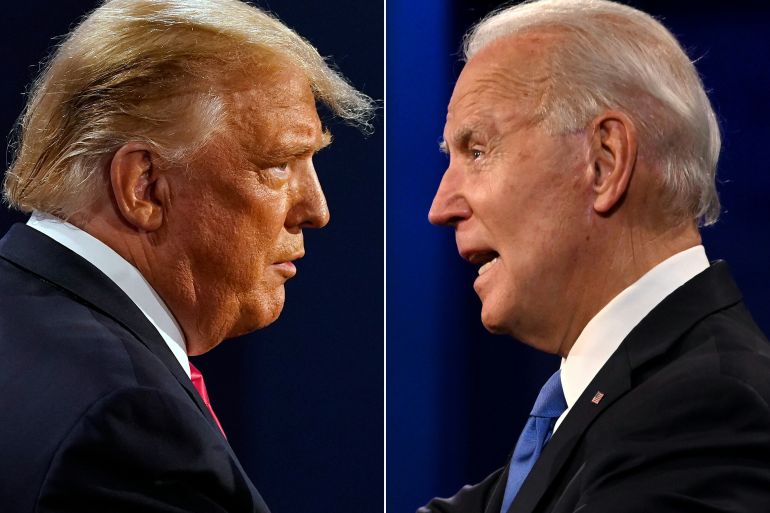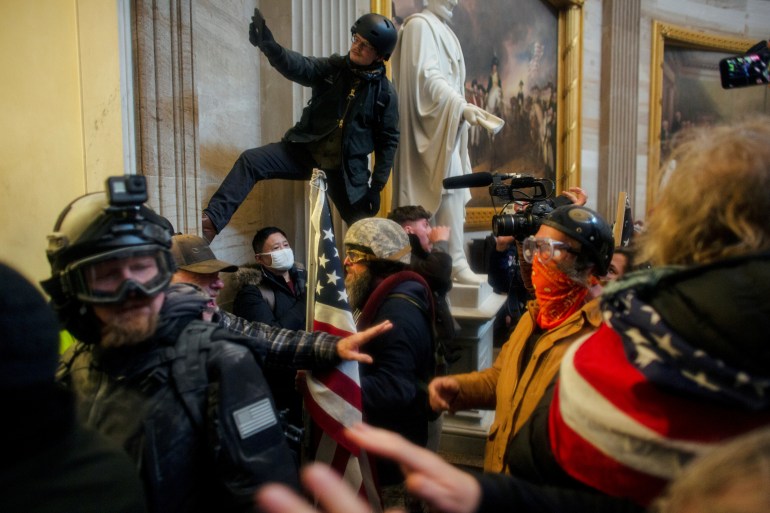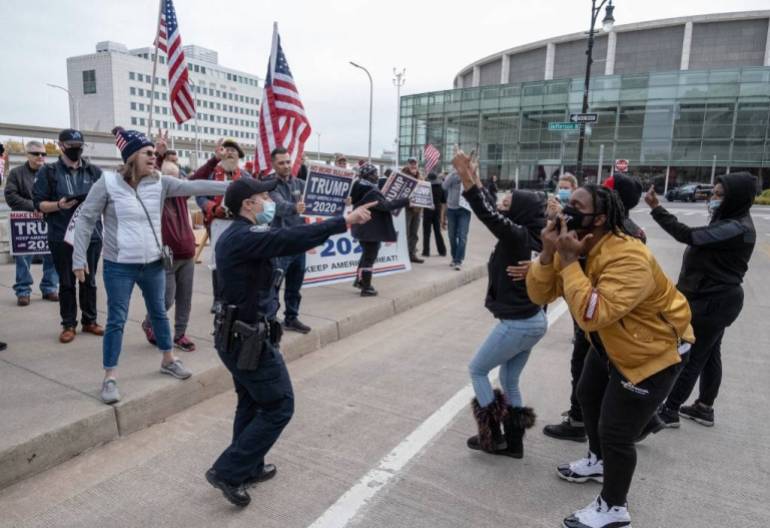Partisan news thrived under Trump. Can Biden bridge the divide?
Americans are just as divided about where they get their news from as they are about the content of the news itself, research shows.

As President Joe Biden’s administration tries to accelerate coronavirus vaccination drives and get Democrats and Republicans in Congress to agree on a massive round of virus relief aid, another — perhaps more daunting — partisan challenge looms for the new occupants of 1600 Pennsylvania Avenue: healing a fractured nation hooked on partisan news.
Fostering trust in the nation’s institutions — including the Fourth Estate — is key to binding up its wounds. But Americans are just as divided about where they get their news from as they are about the content of the news itself.
Keep reading
list of 4 itemsThe post-election media divide in the US
Is Murdoch media facing a reckoning in Australia?
GameStop: Why social media-driven traders are beating Wall Street
That means Biden has not only inherited a country reeling from a violent insurrection at the United States Capitol building a week before his inauguration but a nation of people deeply distrustful of what the “other side” thinks, reads and watches.
Take, for example, the proliferation of the QAnon conspiracy theory, whose followers have been banned from social media platforms for believing, among other things, that Biden is part of a satanic cabal and will be ousted by former President Donald Trump in March.
The media’s challenge — how to cover a country where the truth no longer feels absolute — is staggering. But there is also the question of whether people will even tune in en masse.
Biden has already demonstrated he won’t be the middle-of-the-night tweeter his predecessor was, and his announcements so far have been more policy heavy than scandal heavy. So what will his administration mean for the media outlets that profit from political news — and is there any hope of bridging the US’s media divide?
Profits and polarisation
Like nearly every other industry, 2020 was an unprecedented year for the news media. Some outlets struggled as the global economic crisis tore into their already razor-thin profit margins. Newspapers saw a 42 percent decrease in advertising revenue in the second quarter of 2020 compared to the previous year, a study by the Pew Research Center found.
But with an audience of people stuck at home and hungry for news about the pandemic and politics, other news outlets experienced their best year ever.
“From 2019 to 2020 specifically, revenue and audience figures for the media have been vastly different,” Elisa Shearer, a Pew research associate focusing on journalism, told Al Jazeera. “For cable TV, Fox News’ ad revenue went up by 41 percent, and for network TV, ad revenue for nightly news went up 11 percent.”
The people who are in those political bubbles, it's actually kind of a small number of the party overall. But they do tend to be more engaged with news overall: they're paying more attention to lots of different topics and they're more consistently opinionated on the left or right.
But for some media outlets, 2020 — with its headline-gripping virus and a contentious presidential election — represented the continuation of an upward trend that began before Trump came on the scene but accelerated dramatically after he took office.
Conservative-leaning Fox News and the liberal-leaning New York Times both saw explosive audience growth during the Trump years. The Times announced it had hit seven million subscribers days before the November 8 election, writing that there was “little doubt that Donald J. Trump’s presidency has helped lift The Times’s subscription business”. Fox News, one of Trump’s favourite channels, clocked its highest ratings ever in 2020, marking its fifth straight year as the most-watched basic cable network.
But the Biden era is already causing a shift. From Election Day 2020 to Inauguration Day 2021, CNN eclipsed Fox as the most-watched cable news network, with 1.8 million total viewers to Fox’s 1.5 million, Nielsen ratings show, and part of that slump can be attributed to the rise of conservative news outlets that have positioned themselves on the far right.
Rise of far-right media
Howard Polskin began exploring right-wing media after Trump was elected in 2016. The tagline of the TheRighting.com, the website he now runs — “alerting liberal audiences to today’s headlines from the right” — is a testament to the US’s polarised media climate.
While far-right media outlets have always been there, Polskin said, “the Trump presidency validated them. What Trump was saying was echoing a lot of what they were reporting on and what their opinions were. And conversely, a lot of their reporting and what they were expressing would then get amplified by President Trump. So they kind of fed off each other.”
As Trump bucked norms that Fox upheld, visitors have increased at far-right websites. Fox.com’s year-over-year unique visitors fell 13 percent in December, while more conservative Newsmax.com registered a 148 percent increase in year-over-year unique visitors to its site the same month, according to ComScore data analysed by TheRighting.com. Far-right Gateway Pundit’s audience surged 199 percent in the same period, and Breitbart News Network saw a 42 percent increase, according to TheRighting.com’s analysis.

The mainstream conservative media’s decision to recognise Biden’s electoral victory also put it at odds with far-right media, which continued to support Trump’s baseless claim that he had won. The chasm widened following the January 6 storming of the Capitol Building by Trump supporters that left at least five people dead.
“In days following the Capitol mayhem, I saw that about half the conservative websites I monitor on a daily basis condemned the insurrection,” Polskin said. “Sadly, I wasn’t surprised to find that many right-wing websites coughed up crazy theories and logic-free conclusions of the January 6 event. It’s a disturbing and twisted version of reality that has been playing for the last four years.”
But, Polskin said, while the facts are at odds, “the media environment is a perfect reflection of the polarisation that exists in our country today.”
Media bubbles
Research shows that while Americans are tuning in to their preferred news sources more, they’re tuning in to each others’ less. A report on media polarisation and the 2020 election by the Pew Research Center asked Americans about their trust or distrust in 30 different sources of political and election news, including newspapers, TV channels, websites and talk radio shows.
Tellingly, “none of the 30 sources is trusted by more than 50 percent of all US adults,” researchers wrote. The Democrats who were polled said they trusted 22 of the 30 news sources, while Republicans distrusted more than 20 of those same news sources.
“Democrats and Republicans really have very different media environments when it comes to political news,” Shearer explained, and the divide has deepened since Pew conducted a similar study in 2014.

Perhaps unsurprisingly, the chasm is widest between the poles of each party: liberal Democrats and conservative Republicans. Sixty-six percent of liberal Democrats in the Pew study said they trusted The New York Times, while only 10 percent of conservative Republicans did. In contrast, 75 percent of conservative Republicans trust Fox News, while 77 percent of liberal Democrats distrust it.
“When you take look at the far-back view looking at the two parties, we see about two in ten — about 20 percent of each party — are in this bubble,” Shearer said. “The people who are in those political bubbles, it’s actually kind of a small number of the party overall. But they do tend to be more engaged with news overall: they’re paying more attention to lots of different topics and they’re more consistently opinionated on the left or right.”
‘Intellectually honest’
It wasn’t just the big media players that saw their audiences grow during the Trump years, either. Smaller publishers of political news rode a wave of surging interest, including those producing newsletters on Substack, a platform favoured by independent writers and publishers.
Steve Hayes launched conservative political newsletter The Dispatch on Substack in October 2019. Hayes and his team projected they could reach 2,000 paying subscribers by the end of 2020. Instead, The Dispatch closed out last year with 20,000 paid subscribers.
The “dramatic growth” of The Dispatch is one that Hayes, the site’s CEO and editor, attributes in part to the site’s “intellectual honesty”.
“We’re conservatives — or centre-right — and we thought it important to level with people about where we’re coming from as we provide them fact-based news and analysis,” Hayes told Al Jazeera.
I think we'd all be a lot better off if people would vary their news diet and consume a variety of different outlets.
“One of the problems with the mainstream media is the pretence that the reporters doing the work — often really good work — don’t have a world view,” he added.
Jill Filipovic writes a newsletter on Substack from her progressive feminist world view. The author of OK Boomer, Let’s Talk: How My Generation Got Left Behind, Filipovic launched her Substack offering two years ago and now writes for “a keyed-in — and opting-in — audience” of a few thousand subscribers, she said.
Although on different parts of the political spectrum, Filipovic and Hayes both cater to audiences seeking out a specific political viewpoint — and wanting to read more from it.
“A lot of folks seek out opinion writing for a deeper dive into issues they care about, or to learn something new,” Filipovic told Al Jazeera. “But others seem to primarily want to confirm their own views and reinforce their priors. Where it gets especially dangerous is when opinion masquerades as objective or balanced reporting.”
“Part of the challenge here is that most folks lack basic media literacy,” she added. “I can’t tell you how often I get emails complaining that I’m a ‘biased journalist’ in response to an op-ed, and it’s like, that’s an opinion editorial! It’s supposed to be biased.”
Hello from the other side
So how can Americans bridge the media divide? Diversifying the outlets they turn to is a start, Hayes said. While many of his site’s readers are conservatives, The Dispatch’s audience also includes people who “look to us to provide an understanding of what sane conservatives believe and why”.
“I think we’d all be a lot better off if people would vary their news diet and consume a variety of different outlets,” Hayes added. “We know that there’s a slice of our membership that is using us to do just that.”
Part of the challenge here is that most folks lack basic media literacy. I can't tell you how often I get emails complaining that I'm a 'biased journalist' in response to an op-ed, and it's like, that's an opinion editorial! It's supposed to be biased.
Part of that, Filipovic said, requires sorting out reporting from opinion even in a polarised media environment.
“On the most basic level, I would love it if more readers understood the division between news and opinion, and sought out both,” she said. “A perfectly objective news source may not exist, but there are a great many news sources that strive to be fair and honest, and that have demanding editorial standards in the service of that goal.”
As for what the ratings and site traffic numbers will look like with Biden in the White House —that depends on how outlets choose to frame their politics coverage without the scandal-driven coverage of the Trump administration, Filipovic said.
“The challenge, I think, will be telling the story of how policy that gets made in Washington translates into the lives of average people in the US and overseas, including people who can’t vote in American elections,” she said. “Politics shapes all of our lives whether we care about it or not; that’s the story we need to tell over the next four years.”